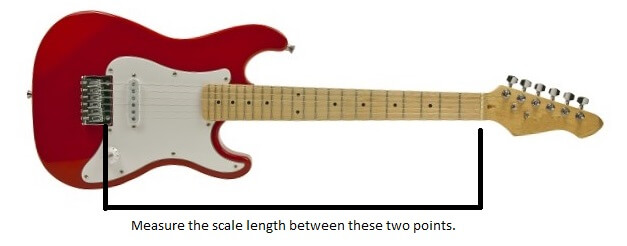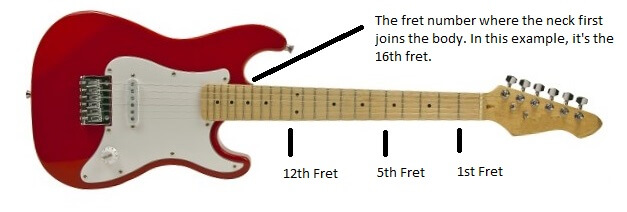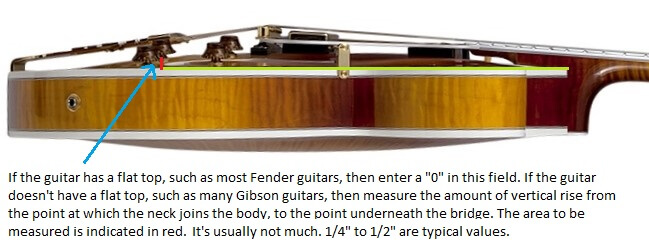When designing a guitar, determining the proper neck angle is important in order to make the instrument playable. Often times, this angle is determined by drawing a full-scale profile of the instrument on a large piece of paper, then taking a protractor and measuring what the string angle should be. While drawing the instrument on paper has some advantages from an artistic point of view, it is a long and cumbersome process to follow if one simply wants to know this angle.
So, the TundraMan is here at your rescue, with a little help from our friend trigonometry. I created this simple calculator that will take the measurements from the guitar and determine the proper neck angle. As an added bonus, it will also determine at what distance the bridge should be located from the point where the neck joins the body. To use the calculator, simply enter the information in the fields, then click on the "calculate" button to view the results.
Here's some more information to help you while entering information in the fields:
The calculator will work with both english and metric measurements. Just select which you want to use, and enter the fields using the appropriate values. Note that if you're entering values in inches, you must use decimals. For example, you would enter 1/4" as .25. If you enter 1/4" and bad things happen, don't say I didn't warn you.
The scale length is simply the distance from the nut to the bridge. More information about scale lengths is available on my fretboard calculator page.
The fret where the neck joins the body must be designated. Often times this join occurs at the same postion as a fret (i.e. the 16th fret) so you can just enter the fret number. However, if the neck join occurs between frets on your guitar, the fret can be entered as a partial (i.e. if on your guitar the neck will join half way between the 16th and 17th frets, you can enter 16.5.)
To determine the height of the fingerboard at the neck join, measure the distance from the top of the guitar to the top of the highest part of the fingerboard, then add the height of the fretwire you plan to use.
The height of the bridge must also be entered. This distance should be measured from the top of the guitar, to the highest point on the string saddle. If the bridge is height adjustable, the measurement should be made with the adjustment at the lowest position (or close to the lowest if you want a little wiggle room.)
For the "increase in top height from neck to bridge" field, you must enter any difference in the height of the guitar top from the point at which the neck joins, to the point underneath the bridge. Many guitars (i.e. Stratocasters, Telecasters, etc.) have a flat top, in which case you would enter "0" because there is no height difference. On carved top guitars, often times the part of the top where the bridge is located sits higher than the end of the body where the neck attaches. In these cases you must specify the amount of rise in the top for the calculation to be accurate.
Getting the proper neck angle on a guitar is imperative to making the guitar play correctly. Not all guitars have a neck angle, so in some cases the correct neck angle is "none". In any event, if you're building a guitar you need to know what angle should be used.
This is one of those instances where a picture is worth 1000 words. Here's a side-view of a guitar with different neck angle/bridge combinations. From this picture, you can see why some guitars need a neck angle. Pardon my homemade picture.
Basically, the neck angle works in conjunction with the bridge height adjustment to hold the strings the proper distance from the fretboard. Too little of a neck angle, and the bridge may not be able to be adjusted low enough to bring the strings down to a comfortable action. Even worse, too much neck angle and the bridge may not be able to raise the strings high enough off of the fretboard to make the guitar playable.
Many Fender guitars (i.e. Strats and Teles) use a bridge that sits at a low enough profile so as not to require a neck angle. Other bridges, such as the Tune-O-Matic found on many Gibson guitars have a much higher profile which requires a neck angle. Every new guitar design should be measured and have the proper neck angle calculated; it's not enough to just assume that because your guitar looks like a Strat, that you don't need a neck angle.
Return To The Main Music Gallery
This page last updated on 06/28/2018








